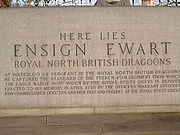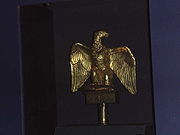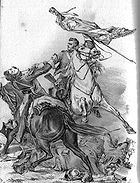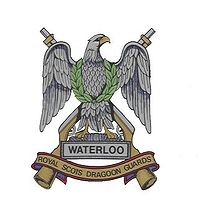
Charles Ewart
Encyclopedia
Ensign Charles Ewart was a Scottish
soldier
of the Royal North British Dragoons (more commonly known as the Scots Greys), famous for capturing the regimental eagle
of the 45e Régiment de Ligne (45th Regiment of the Line) at the Battle of Waterloo
.
He was born near Kilmarnock
in 1769, and enlisted in the cavalry
at the age of twenty. He fought in a number of actions in the French Revolutionary Wars
, was briefly taken prisoner, and emerged from the conflict as a Sergeant in the regiment. Over the next two decades he became a well-respected and competent soldier, serving as fencing
-master of the regiment; a heavily-built man, reported as 6'4" tall and "of Herculean strength" he was an expert swordsman and accomplished rider.

regiments held in reserve by Wellington
. In the line of battle, General Thomas Picton
's 5th Division was held in reserve, on the right of the Allied line, behind the Dutch-Belgian 2nd Division. The 5th contained a number of experienced veteran units from the Peninsular War
, including the 92nd Foot (Gordon Highlanders)
.
After a heavy exchange of fire, the Belgians were forced to fall back to the far side of the ridge on which they were stationed, and the 5th Division moved forward over the crest of the ridge to hold the line. After the heavy exchange of fire continued, with the 5th holding firm, it was decided that the division should charge to break up the French columns; the cavalry held in reserve were brought forward, and passed through the ranks of the infantry and into action.
At this point, the Gordon Highlanders were exchanging fire with the 1st Battalion of the 45th, which was deploying around thirty yards to their front. The Greys quickly and unexpectedly passed through the infantry, moved forward the short distance between the lines, and broke through to the centre of the French infantry as it was forming into a defensive line. In the confusion that followed, the 45th was effectively broken as an organised unit, and the eagle it carried was quickly seized by Sergeant Ewart, in close fighting with a number of Frenchmen.
To prevent it being recaptured, he was ordered to take it to safety; he did, but paused for some time overlooking the battlefield before finally carrying the trophy to Brussels
. Whilst the brigade had not taken significant losses, they were disorganised, and carried forward to attack French artillery; charged by French cavalry in turn, they took heavy losses, and played no further part in the battle.
and published the story of this Ayrshire hero in the Observer. Charles Ewart was about 6 feet high, firmly knit, with a countenance indicative of high mental and physical energies.
In the retreat of the British through Holland after the disastrous Battle of Nimguen, Ewart one day heard the wailing sounds of a child coming from close to the roadside. He dismounted and found a woman and child lying in the snow. The mother was dead, but the infant, still clinging to life, was in the act of suckling from the breast of its lifeless parent. Ewart rescued the baby and on reaching the encampment for the evening, met with his colonel who offered to defray the expenses of a wet nurse. Great difficulties were encountered in this, however he was successful and also fortunate in discovering the father of the child, a sergeant in the 60th regiment. Some years later the father, now a sergeant-major and father of a healthy son, fortuitously met with Ewart. He tried to give Ewart a sum of money, which upon being firmly rejected, was replaced with the gift of a silver watch, and this was finally accepted as a memento of the events.
 At Waterloo, Ewart was involved in a hand to hand combat with an officer, whom he was about to cut down, when a young ensign of the Greys offered to instead take the Frenchman to the rear as a prisoner. No sooner had he agreed to the request when he heard the report of a pistol and upon turning, saw the ensign falling from his horse, and the officer in the act of replacing the weapon with which he had dispatched the life of his preserver. Thus enraged, Ewart cut down the officer, deaf to his pleadings for mercy. Dashing forward he now found himself close to the standard-bearer of one of the French Invincible regiments. A short and deadly conflict ensued and as the staff had stuck fast in the ground he was able to lay hold of it without further trouble. Looking round he saw a lancer single him out, gallop forward and hurl his spear at his breast. He had just enough strength to ward off the blow, so that the lance only grazed his side; then raising himself up in his stirrups, he brought his opponent to the ground with one cut of his sword. When riding away with the Eagle he experienced another narrow escape, for a wounded Frenchman, who he had taken for dead, raised himself up on one elbow and fired at him as he passed. The ball fortunately missed him and he was able to take his prize to the rear.
At Waterloo, Ewart was involved in a hand to hand combat with an officer, whom he was about to cut down, when a young ensign of the Greys offered to instead take the Frenchman to the rear as a prisoner. No sooner had he agreed to the request when he heard the report of a pistol and upon turning, saw the ensign falling from his horse, and the officer in the act of replacing the weapon with which he had dispatched the life of his preserver. Thus enraged, Ewart cut down the officer, deaf to his pleadings for mercy. Dashing forward he now found himself close to the standard-bearer of one of the French Invincible regiments. A short and deadly conflict ensued and as the staff had stuck fast in the ground he was able to lay hold of it without further trouble. Looking round he saw a lancer single him out, gallop forward and hurl his spear at his breast. He had just enough strength to ward off the blow, so that the lance only grazed his side; then raising himself up in his stirrups, he brought his opponent to the ground with one cut of his sword. When riding away with the Eagle he experienced another narrow escape, for a wounded Frenchman, who he had taken for dead, raised himself up on one elbow and fired at him as he passed. The ball fortunately missed him and he was able to take his prize to the rear.
In 1816 he was invited to a Waterloo dinner at Leith
near Edinburgh
, where Sir Walter Scott proposed his health and invited him to speak. Lieutenant Ewart begged that he might be excused, saying that he would rather fight the battle of Waterloo over again, than face so large an assemblage.

 The capture of the eagle is one of the most prized honours of the Scots Greys and, in commemoration of this, their cap badge
The capture of the eagle is one of the most prized honours of the Scots Greys and, in commemoration of this, their cap badge
shows the eagle. As with many such incidents, the story of the capture has grown greatly over the years, to the status of a legend; it is often told that the Greys charged the 45th, with the Gordons seizing hold of their stirrup-leathers and carrying themselves along into the fray, crying "Scotland Forever!". On the contrary, modern research suggests that there was no charge, but rather a quick walk (commonly used by large cavalry formations to preserve order when speed of arrival is irrelevant) into the advancing French line. The rest of the British Army called the Greys The Birdcatchers, as a wry nickname for the eagles capture.
Throughout the entire Waterloo campaign, only two French Eagles were captured during battle, both by the Union Brigade in this particular action. Ewart was hailed a hero, honoured, and travelled the country giving speeches. He was given a commission as an ensign
(a second lieutenancy) in the 5th Veteran Battalion in 1816, and left the army when this unit was disbanded in 1821. He lived in Salford, and in his final years at Davyhulme
, near Manchester, retiring on the full pay of an ensign, and died in 1846. His grave was paved over and forgotten for many years, being uncovered in the 1930s, and he was reburied by the Royal Scots Greys (as they were then titled) on the esplanade
of Edinburgh Castle
in 1938.
Today, he is best known to the general populace by a pub in Edinburgh
which bears his name, the Ensign Ewart; it is located next to the Castle esplanade, where a monument marks his burial place.
Scotland
Scotland is a country that is part of the United Kingdom. Occupying the northern third of the island of Great Britain, it shares a border with England to the south and is bounded by the North Sea to the east, the Atlantic Ocean to the north and west, and the North Channel and Irish Sea to the...
soldier
Soldier
A soldier is a member of the land component of national armed forces; whereas a soldier hired for service in a foreign army would be termed a mercenary...
of the Royal North British Dragoons (more commonly known as the Scots Greys), famous for capturing the regimental eagle
French Imperial Eagle
French Imperial Eagle refers to the figure of an eagle on a staff carried into battle as a standard by the Grande Armée of Napoleon I during the Napoleonic Wars....
of the 45e Régiment de Ligne (45th Regiment of the Line) at the Battle of Waterloo
Battle of Waterloo
The Battle of Waterloo was fought on Sunday 18 June 1815 near Waterloo in present-day Belgium, then part of the United Kingdom of the Netherlands...
.
He was born near Kilmarnock
Kilmarnock
Kilmarnock is a large burgh in East Ayrshire, Scotland, with a population of 44,734. It is the second largest town in Ayrshire. The River Irvine runs through its eastern section, and the Kilmarnock Water passes through it, giving rise to the name 'Bank Street'...
in 1769, and enlisted in the cavalry
Cavalry
Cavalry or horsemen were soldiers or warriors who fought mounted on horseback. Cavalry were historically the third oldest and the most mobile of the combat arms...
at the age of twenty. He fought in a number of actions in the French Revolutionary Wars
French Revolutionary Wars
The French Revolutionary Wars were a series of major conflicts, from 1792 until 1802, fought between the French Revolutionary government and several European states...
, was briefly taken prisoner, and emerged from the conflict as a Sergeant in the regiment. Over the next two decades he became a well-respected and competent soldier, serving as fencing
Fencing
Fencing, which is also known as modern fencing to distinguish it from historical fencing, is a family of combat sports using bladed weapons.Fencing is one of four sports which have been featured at every one of the modern Olympic Games...
-master of the regiment; a heavily-built man, reported as 6'4" tall and "of Herculean strength" he was an expert swordsman and accomplished rider.

The engagement
At Waterloo, the Greys were part of the Union Brigade, a formation of heavy cavalryHeavy cavalry
Heavy cavalry is a class of cavalry whose primary role was to engage in direct combat with enemy forces . Although their equipment differed greatly depending on the region and historical period, they were generally mounted on large powerful horses, and were often equipped with some form of scale,...
regiments held in reserve by Wellington
Arthur Wellesley, 1st Duke of Wellington
Field Marshal Arthur Wellesley, 1st Duke of Wellington, KG, GCB, GCH, PC, FRS , was an Irish-born British soldier and statesman, and one of the leading military and political figures of the 19th century...
. In the line of battle, General Thomas Picton
Thomas Picton
Lieutenant General Sir Thomas Picton GCB was a Welsh British Army officer who fought in a number of campaigns for Britain, and rose to the rank of lieutenant general...
's 5th Division was held in reserve, on the right of the Allied line, behind the Dutch-Belgian 2nd Division. The 5th contained a number of experienced veteran units from the Peninsular War
Peninsular War
The Peninsular War was a war between France and the allied powers of Spain, the United Kingdom, and Portugal for control of the Iberian Peninsula during the Napoleonic Wars. The war began when French and Spanish armies crossed Spain and invaded Portugal in 1807. Then, in 1808, France turned on its...
, including the 92nd Foot (Gordon Highlanders)
The Gordon Highlanders
The Gordon Highlanders was a British Army infantry regiment from 1794 until 1994. The regiment took its name from the Clan Gordon and recruited principally from Aberdeen and the North-East of Scotland.-History:...
.
After a heavy exchange of fire, the Belgians were forced to fall back to the far side of the ridge on which they were stationed, and the 5th Division moved forward over the crest of the ridge to hold the line. After the heavy exchange of fire continued, with the 5th holding firm, it was decided that the division should charge to break up the French columns; the cavalry held in reserve were brought forward, and passed through the ranks of the infantry and into action.
At this point, the Gordon Highlanders were exchanging fire with the 1st Battalion of the 45th, which was deploying around thirty yards to their front. The Greys quickly and unexpectedly passed through the infantry, moved forward the short distance between the lines, and broke through to the centre of the French infantry as it was forming into a defensive line. In the confusion that followed, the 45th was effectively broken as an organised unit, and the eagle it carried was quickly seized by Sergeant Ewart, in close fighting with a number of Frenchmen.
-
- "One made a thrust at my groin, I parried him off and cut him down through the head. A lancerLancerA lancer was a type of cavalryman who fought with a lance. Lances were used in mounted warfare by the Assyrians as early as and subsequently by Greek, Persian, Gallic, Han-Chinese, nomadic and Roman horsemen...
came at me - I threw the lance off by my right side and cut him through the chin and upwards through the teeth. Next, a foot soldier fired at me and then charged me with his bayonetBayonetA bayonet is a knife, dagger, sword, or spike-shaped weapon designed to fit in, on, over or underneath the muzzle of a rifle, musket or similar weapon, effectively turning the gun into a spear...
, which I also had the good luck to parry, and then I cut him down through the head".
- "One made a thrust at my groin, I parried him off and cut him down through the head. A lancer
To prevent it being recaptured, he was ordered to take it to safety; he did, but paused for some time overlooking the battlefield before finally carrying the trophy to Brussels
Brussels
Brussels , officially the Brussels Region or Brussels-Capital Region , is the capital of Belgium and the de facto capital of the European Union...
. Whilst the brigade had not taken significant losses, they were disorganised, and carried forward to attack French artillery; charged by French cavalry in turn, they took heavy losses, and played no further part in the battle.
The reminiscences of James Paterson
James Paterson was a printer, editor and historian born and throughout his working life, mostly based, in Ayrshire. In 1846 he and several others dined with Charles Ewart at the Monument Inn in KilmarnockKilmarnock
Kilmarnock is a large burgh in East Ayrshire, Scotland, with a population of 44,734. It is the second largest town in Ayrshire. The River Irvine runs through its eastern section, and the Kilmarnock Water passes through it, giving rise to the name 'Bank Street'...
and published the story of this Ayrshire hero in the Observer. Charles Ewart was about 6 feet high, firmly knit, with a countenance indicative of high mental and physical energies.
In the retreat of the British through Holland after the disastrous Battle of Nimguen, Ewart one day heard the wailing sounds of a child coming from close to the roadside. He dismounted and found a woman and child lying in the snow. The mother was dead, but the infant, still clinging to life, was in the act of suckling from the breast of its lifeless parent. Ewart rescued the baby and on reaching the encampment for the evening, met with his colonel who offered to defray the expenses of a wet nurse. Great difficulties were encountered in this, however he was successful and also fortunate in discovering the father of the child, a sergeant in the 60th regiment. Some years later the father, now a sergeant-major and father of a healthy son, fortuitously met with Ewart. He tried to give Ewart a sum of money, which upon being firmly rejected, was replaced with the gift of a silver watch, and this was finally accepted as a memento of the events.

In 1816 he was invited to a Waterloo dinner at Leith
Leith
-South Leith v. North Leith:Up until the late 16th century Leith , comprised two separate towns on either side of the river....
near Edinburgh
Edinburgh
Edinburgh is the capital city of Scotland, the second largest city in Scotland, and the eighth most populous in the United Kingdom. The City of Edinburgh Council governs one of Scotland's 32 local government council areas. The council area includes urban Edinburgh and a rural area...
, where Sir Walter Scott proposed his health and invited him to speak. Lieutenant Ewart begged that he might be excused, saying that he would rather fight the battle of Waterloo over again, than face so large an assemblage.
The legend


Cap badge
A cap badge, also known as head badge or hat badge, is a badge worn on uniform headgear and distinguishes the wearer's nationality and/or organisation. The wearing of cap badges is a convention commonly found among military and police forces, as well as uniformed civilian groups such as the Boy...
shows the eagle. As with many such incidents, the story of the capture has grown greatly over the years, to the status of a legend; it is often told that the Greys charged the 45th, with the Gordons seizing hold of their stirrup-leathers and carrying themselves along into the fray, crying "Scotland Forever!". On the contrary, modern research suggests that there was no charge, but rather a quick walk (commonly used by large cavalry formations to preserve order when speed of arrival is irrelevant) into the advancing French line. The rest of the British Army called the Greys The Birdcatchers, as a wry nickname for the eagles capture.
Throughout the entire Waterloo campaign, only two French Eagles were captured during battle, both by the Union Brigade in this particular action. Ewart was hailed a hero, honoured, and travelled the country giving speeches. He was given a commission as an ensign
Ensign (rank)
Ensign is a junior rank of a commissioned officer in the armed forces of some countries, normally in the infantry or navy. As the junior officer in an infantry regiment was traditionally the carrier of the ensign flag, the rank itself acquired the name....
(a second lieutenancy) in the 5th Veteran Battalion in 1816, and left the army when this unit was disbanded in 1821. He lived in Salford, and in his final years at Davyhulme
Davyhulme
Davyhulme is a locality within the Metropolitan Borough of Trafford in Greater Manchester, England. Historically part of Lancashire, it is contiguous with the town of Urmston....
, near Manchester, retiring on the full pay of an ensign, and died in 1846. His grave was paved over and forgotten for many years, being uncovered in the 1930s, and he was reburied by the Royal Scots Greys (as they were then titled) on the esplanade
Esplanade
An esplanade is a long, open, level area, usually next to a river or large body of water, where people may walk. The original meaning of esplanade was a large, open, level area outside fortress or city walls to provide clear fields of fire for the fortress' guns...
of Edinburgh Castle
Edinburgh Castle
Edinburgh Castle is a fortress which dominates the skyline of the city of Edinburgh, Scotland, from its position atop the volcanic Castle Rock. Human habitation of the site is dated back as far as the 9th century BC, although the nature of early settlement is unclear...
in 1938.
Today, he is best known to the general populace by a pub in Edinburgh
Edinburgh
Edinburgh is the capital city of Scotland, the second largest city in Scotland, and the eighth most populous in the United Kingdom. The City of Edinburgh Council governs one of Scotland's 32 local government council areas. The council area includes urban Edinburgh and a rural area...
which bears his name, the Ensign Ewart; it is located next to the Castle esplanade, where a monument marks his burial place.

